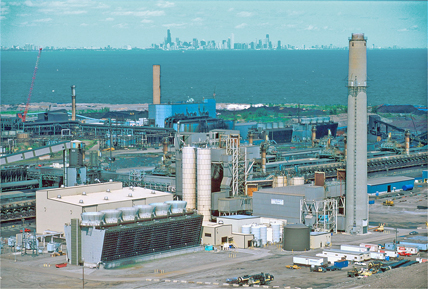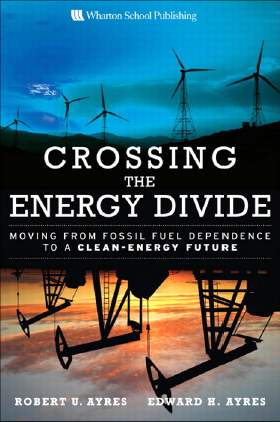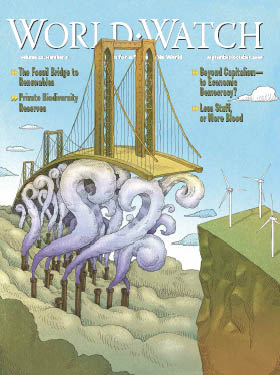Bridging energy chasm the Ayres rock

Strong on Specifics: ArcelorMittal’s Lake Michigan steel works where recycled energy produces 90 megawatts of emission-free energy. The Ayres brothers rock the notion that a rapid switch to renewables is possible, without first urgently increasing energy service. image Recycled Energy Development
Most are utterly unrepentant. Free-market high priests appear more than happy for the subprime mortgage market to take the fall for the global economic downturn—all those folk with no business aspiring to home ownership, really!
Other economists point to different culprits, from the failure of economics to value the growth of happiness, rather than growth per se, to the failure to drive a clean industrial revolution. Plenty acknowledge that economic growth has to be uncoupled from population growth, although some are entirely sanguine about the prospects of the planet supporting 9 or 11 billion souls.
Then there is Robert U Ayres, economist and physicist. Actually, that should Robert Ayres and Reiner Kūmmel, physicist. Ayres and Kūmmel, independently, identified the reduction in the cost of energy service as a principal driver of economic growth. Previously, the dirty secret of neoliberal economics was that it couldn’t explain the growth driver, terming it ‘technological progress’, ‘unexplained residual’ or ‘the Solow residual’. Nobel prizewinner Robert Solow characterised it as:
a measure of our ignorance.

Mixed Metaphor: The Ayres brothers’ urgent and beautifully written book is vastly better than its cover and less-than-optimal title. image Wharton School Publishing
In Crossing the Energy Divide, subtitled Moving from Fossil Fuel Dependence to a Clean-Energy Future, brothers Robert and Edward Ayres say
When [economists] can’t say exactly what ‘technological progress’ really means or how it is produced, they’re admitting to a large gap in their predictive capability…
Undeterred, whenever the economic wheels became wobbly, economists would reassure the world that all would be well, that the fundamentals were sound—without understanding what the fundamentals were.
Now, it’s not always necessary to understand a thing for it to work well in one’s hands. Legendary motor racing driver Stirling Moss was notoriously disinterested in the mechanics of the cars he drove so sublimely. The Wright brothers, and most aircraft designers since, didn’t let the lack of a sound theory of flight stop them from employing the empirical method to perfect stringently efficient wing sections.
Because the cost of energy service steadily declined, it didn’t matter it was not understood that this was ‘the real engine of economic growth.’ But with peak oil production poised to send prices soaring, the wheels will not just wobble, but fall off world’s economies, and fall off before fossil-fuel-free energy systems can be put in place—never mind the need for these systems to be non –greenhouse gas –emitting. Unless…
Dr Ayres is an authority on energy efficiency, and it happens that the United States is particularly inefficient, achieving only about 13% overall efficiency. Double that abysmal figure and the economy will recover—potentially, sufficiently to build a fossil-free energy infrastructure. Other countries can make similar gains, although many already are much less inefficient—Japan’s overall efficiency is about 20%. America’s energy inefficiency is largely down to the monopoly of coal-burning electricity utilities. Break those monopolies, and others can contribute by turning waste energy into power and selling it. Currently, unless the potential customer is alongside, power generated from a steel works furnace, for example, cannot be supplied to a neighbour—legally, competing power cannot cross a public street.

Perfect Cover: The World Watch magazine Ayres brothers’ cover story illustration deserved to be the cover of their crucial and well-written book. Illustrator Wesley Bedrosian
A strength of Crossing the Energy Divide is the eloquence of the writing—presumably reflecting the skills of co-author younger brother, Edward, who until recently edited the World Watch magazine. A weakness is the title, which mixes the chasm metaphor used throughout the book—down to the girders of the bridge required to cross that energy chasm. Thus the book would have been better-titled Crossing the Energy Chasm, irrespective of it being the title of a succinct piece by counterterrorism-expert-turned-sustainable-communities-advocate John Robb. Bridging the Energy Chasm is more descriptive, but looses the nice alliteration. And although Crossing the Energy Divide could have milked the Great Divide metaphor, this wouldn’t be the first book to have had a half-baked name imposed upon it by a publisher or its marketing muscle.
A major departure from other works on the non –fossil fuel future is that this book concentrates on the immediately achievable, technically. None of the solutions require unproven or yet-to-be-developed technologies. But the Ayres brothers argue that only by keeping the cost of energy service low will the United States retain the productive capability to build the new, distributed, non-carbon infrastructure. This is completely at odds with the prevailing wisdom that only by increasing the price of energy will non-carbon energy initiatives be rewarded.
The book’s big-ticket item, cogeneration, so lacking in the United States, has been par for the course at Glenbrook steel mill since the late 1970s. Nor, with Aotearoa’s almost total lack of comparative heavy industry, is there nearly the scope for energy efficiency improvements in that field. However the other proven technology advocated, combined heat and power, may be more relevant. At its simplest, natural gas is burned to generate electricity and the copious heat produced is used rather than wasted to the atmosphere or the nearest body of water. Or used in the eye-wateringly capital and energy –intensive sewage treatment scheme a self-interested Genesis Energy baldly proposes for Helensville. A less predatory option would involve numerous small, combined heat and power plants providing cheap hot water and heating for the likes of Helensville’s schools and retirement villages.
As for Aotearoa, the Ayres would probably advocate extracting better energy service from electricity generally. The United States produces less than 10% of its power from non-fossil sources, compared to more than half for Aotearoa—thanks mostly to hydro. A great place to start would be heat-pump water heaters, which can triple energy service—in addition to solar, of course. Meantime, relying on the market to phase out fossil-fuel use by attempting to tweak the economic playing field with emissions trading schemes is unproven. It is about as convincing as attempting to discourage an invading army with the threat of an income tax increase. Governments must inform industry that fossil fuel use will be curtailed, and to a specific, provisional, timescale: Adapt quickly or shut up shop.
By taking what the Aryes call a shotgun approach to stimulus spending, the United States has just blown its best chance of bridging the energy chasm, and in the process made the chasm that much wider.
The Aryes’ plan is conceivably the last chance to cross the chasm.
